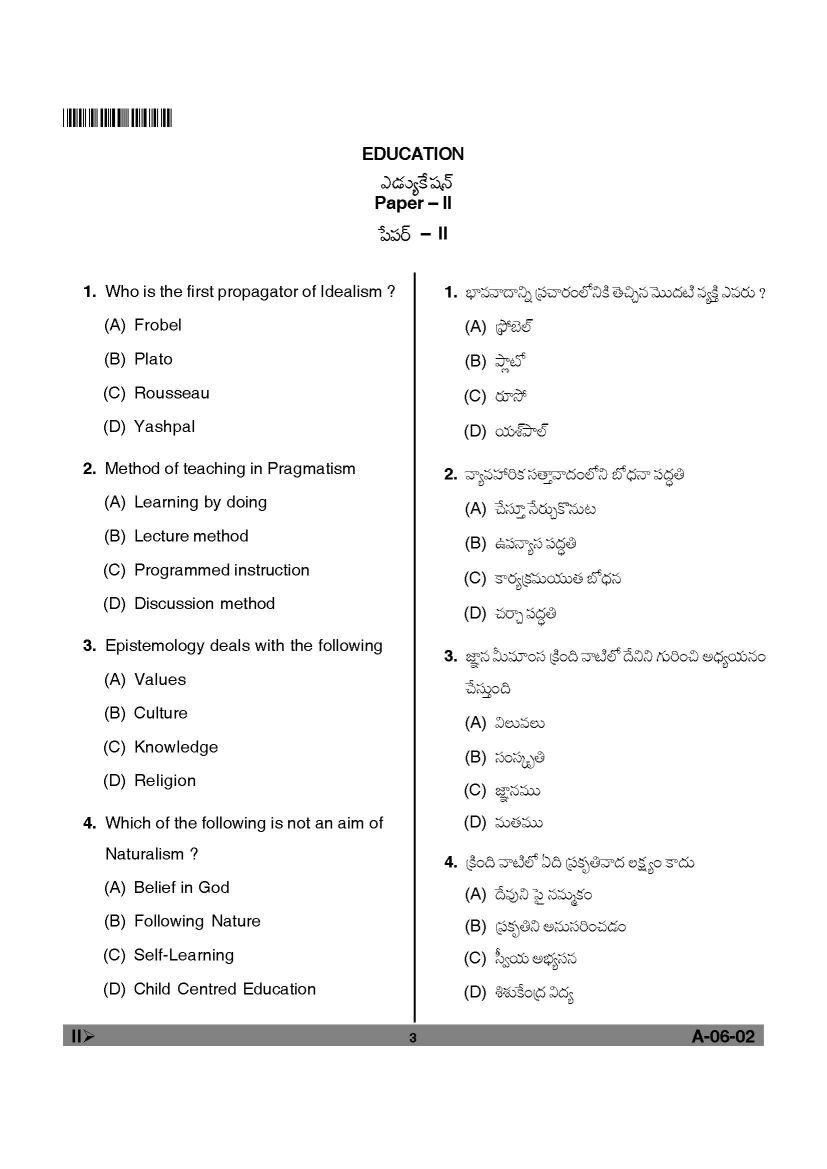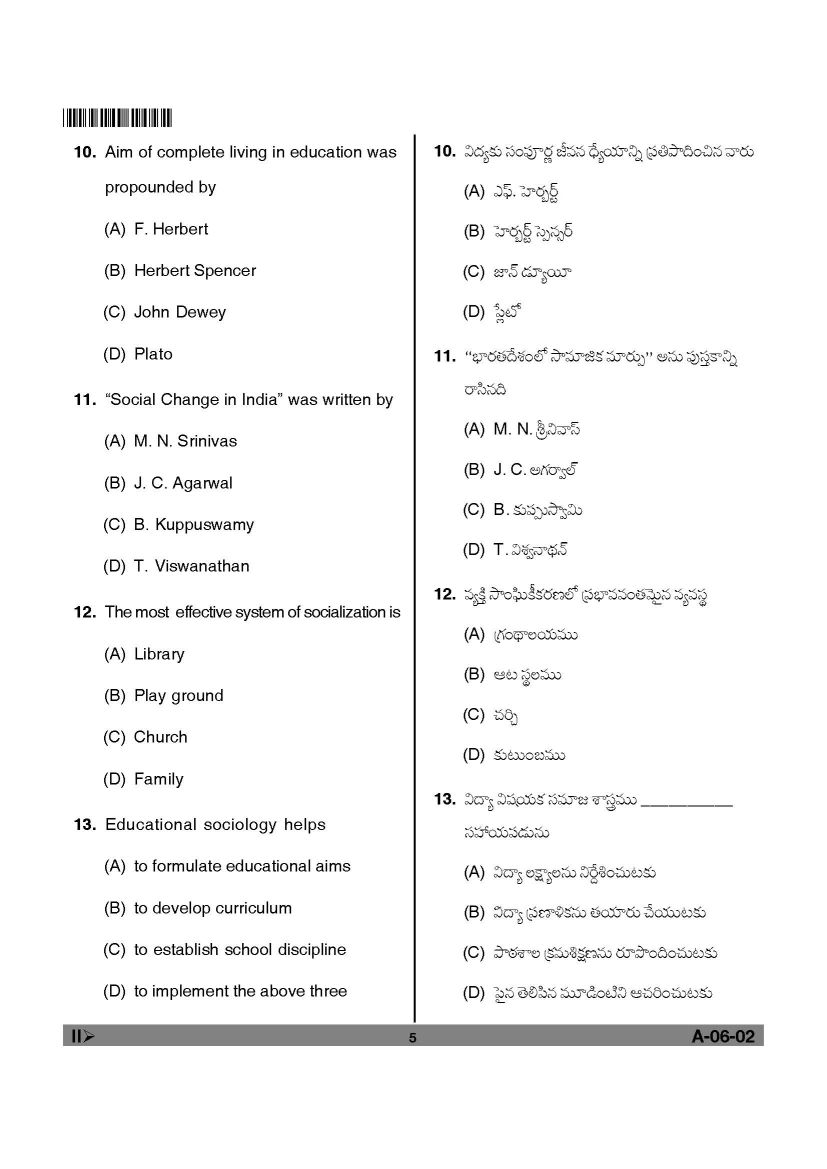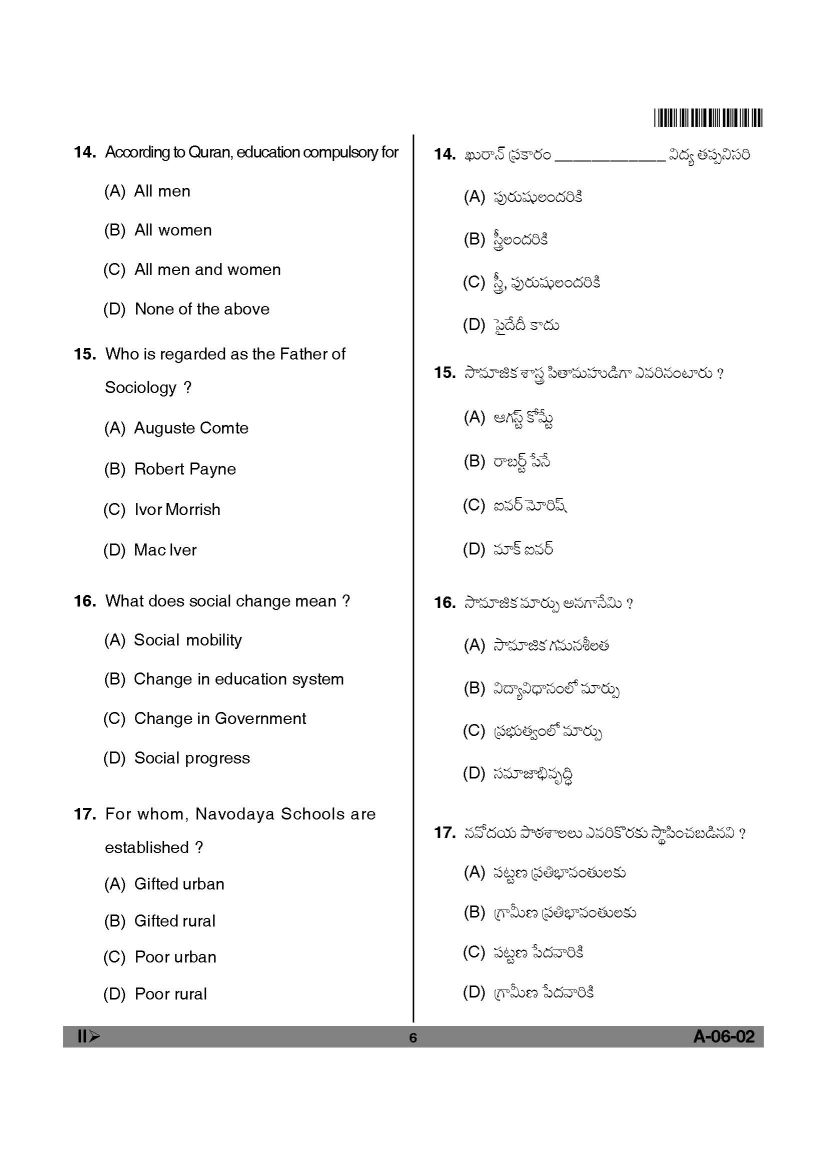| Re: APSET Education Model Question Papers
As you want I am here providing you sample paper of the Education paper of the APSET exam.
Sample paper :
1. What is the main concern of Ontology ?
(A) Value (B) Reality
(C) Truth (D) Matter
2. Who propagated the concept of ‘learning
in communion with nature’ ?
(A) Vivekananda
(B) Aurobindo
(C) Tagore
(D) Gandhi
3. The knowledge that is dependent on
experience/evidence is called as
(A) Experiential knowledge
(B) ‘apriori’ knowledge
(C) Appropriate knowledge
(D) ‘aposteriori’ knowledge
4. Which of the following helps in attaining
Intuitive knowledge ?
i) Internal Experience
ii) Social Evidence
iii) External Experience
iv) Empirical Evidence
(A) i and ii
(B) iii and iv
(C) i and iii
(D) ii and iv
5. Match the following :
a. Metaphysics 1. Knowledge, its
structure
b. Epistemology 2. The universe is
governed by law of
nature
c. Naturalism 3. Principles of conduct
d. Ethics 4. Reality, its nature
a b c d
(A) 1 3 2 4
(B) 4 1 2 3
(C) 4 2 3 1
(D) 1 3 4 2
6. Which school of thought mainly advocates
that a child is an integral part of ultimate
universe ?
(A) Naturalism (B) Pragmatism
(C) Realism (D) Idealism
7. Who is the founder of pragmatism ?
(A) Dewey (B) James
(C) Kilpatric (D) Peirce
8. Which school of thought emphasises mind
over matter ?
(A) Idealism (B) Realism
(C) Materialism (D) Naturalism
9. Match the following :
a) Buddhism 1. Knowledge section
b) Jainism 2. Consciousness and
matter
c) Sankhya 3. Four noble truths
d) Vedanta 4. Non-violence
10. The focus of logical empiricism is on
(A) Scientific methodology
(B) Speculative methodology
(C) Both
(D) None
11. The ‘Sankhya Darsana’ is advocated by
(A) Jaimini
(B) Kanada
(C) Goutama
(D) Kapila
12. Which of the following is not associated
with Rabindranath Tagore ?
(A) Theosophical Society
(B) Viswabharathi
(C) Nobel Prize
(D) National Anthem
13. Which of the following is the first
socialization agent ?
(A) School
(B) Community
(C) Home
(D) Society
14. Critically judge the following :
Assertion (A) : Construction of dams for
irrigation is necessary for
national development.
Reason (R) : Construction of dams will
dislodge many ethnic
groups from their
habitations.
(A) Both (A) and (R) are true
(B) Both (A) and (R) are false
(C) Only (A) is true, but (R) is false
(D) Only (R) is true
15. Modernization is
(A) Development of Western Outlook
(B) Acculturation
(C) Enculturation
(D) Development of Rational Outlook
16. All the following are Fundamental Rights
guaranteed by the Indian Constitution
except
(A) the right to equality
(B) the right against exploitation
(C) the right to employment
(D) the right to freedom of religion
17. Social reform aims at changing the
(A) basic values of the society
(B) norms of the group
(C) religious practices
(D) habits of the individuals
18. Social development is essentially a matter
of
(A) conformity to the demands of the
individual
(B) the achievement of social security
and acceptance
(C) the integration of one’s purposes with
those of the social order
(D) the development of one’s own skills
19. Which of the following is not an attribute
of National Integration ?
(A) cultural cohesion
(B) human dignity
(C) national identity
(D) sentimental prejudices
20. In his/her relationships with students, a
teacher should be
(A) stern and unapproachable
(B) free and easily mixing
(C) friendly and dignified
(D) sarcastic and criticizing
21. If an elder child behaves like an infant when
a new sibling is born, it refers to
(A) Repression
(B) Regression
(C) Rationalization
(D) Reaction formation
22. Which of the matching of intelligence type
to the type of the people of specific fields is
correct ?
(A) Physicists have Interpersonal
Intelligence
(B) Surgeons have Bodily-kinaesthetic
Intelligence
(C) Sales persons have Spatial
Intelligence
(D) Painters have Logico-mathematical
Intelligence
23. The sequence of the process of creativity
(A) Illumination, incubation, verification,
preparation
(B) Preparation, incubation, illumination,
verification
(C) Preparation, illumination, incubation,
verification
(D) Verification, preparation, incubation,
illumination
Read the following passage and answer
the questions 24 and 25
The mechanism of interference is one of the
responsible factors for forgetting. It has the
negative inhibiting effect of one learning
experience on another. It refers to the
condition of a new learning working
backward to impair the retention of old
learning or the old learning working forward
to disrupt later learning, which are termed
as retro-active and pro-active inhibitions
respectively. Another explanation for
forgetting is that due to lapse of time the learnt
material decays through disuse.
24. According to the theory of interference,
proactive interference is the
(A) determental effect of prior learning on
later learning
(B) determental effect of later learning on
prior learning
(C) determental effect of decay
(D) none of the above
25. Interference theory explains inhibitions
when
(A) similarities are more in learning of the
materials
(B) dissimilarities are more in learning of
the materials
(C) both A and B
(D) none of the above
26. The unconscious elements of personality
cannot be studied by the following test
(A) Sentence completion test
(B) Story completion test
(C) Socio-drama
(D) Sociogram
27. According to Kohlberg, which stage
correctly matches with age ?
(A) Punishment and obedience 2 to
4 years
(B) Universal ethical principles after
13 years
(C) Utility of individual rights 10 to
12 years
(D) Instrumental purpose and exchange
after 12 years
28. Which of the following is a creativity
tests ?
(A) Raven’s Progressive tests
(B) Stanford Binet’s tests
(C) Torrence tests
(D) Pass along tests
29. The following does not enrich the gifted
children
(A) Work on independent projects
(B) Prepare reports of the activities
(C) Library work
(D) Double promotion
30. The boy learned to be afraid of maths but
not afraid of the mathematics teacher. It is
due to
(A) Multiple discrimination
(B) Stimulus discrimination
(C) Response discrimination
(D) Generalization
31. Good adjustment is
I. Self-oriented
II. Reality-oriented
III. Situation-oriented
IV. People-oriented
(A) I and III (B) II and III
(C) I and IV (D) I and II
32. Army Alpha test is
I. a group test
II. an individual test
III. a verbal test
IV. Non-verbal test
(A) II and III (B) I and IV
(C) I and III (D) II and IV
33. The method(s) suitable to learn the lengthy
material
I. Whole method
II. Part method
III. Spaced method
IV. Recitation method
(A) I and III (B) II and III
(C) I and IV (D) II and IV
34. Developmental needs in human beings
according to Maslow in their sequence
1. Safety need
2. Food need
3. Self esteem need
4. Need for affection
(A) 1, 2, 3, 4 (B) 1, 4, 3, 2
(C) 1, 2, 4, 3 (D) 2, 1, 4, 3
35. Identify the correct sequence in Bandura’s
social learning.
(A) Reinforcement, attention,
reproduction, retention
(B) Reinforcement, retention, attention,
reproduction
(C) Attention, retention, reproduction,
reinforcement
(D) Attention, retention, reinforcement,
reproduction
36. Guidance at school level mainly aims at
I. School excellence
II. Academic excellence
III. Human excellence
IV. Family excellence
(A) I and III
(B) II and III
(C) III and IV
(D) II and IV
37. Out of the following questions which one
doesnot lend itself to action research in
schools ?
(A) How did students in the 20th century
study ?
(B) How can academic content be
presented to improve learning ?
(C) How can teachers encourage
students to think critically ?
(D) Does involvement of parents in
child’s education improve their
achievement ?
38. Which of the following are common
elements of a research proposal and a
research report ?
1. Objectives and Hypothesis
2. Suggestions for further research
3. Need and rationale of study
4. Sampling and data collection
procedures
(A) 1, 2, 3 (B) 2, 3, 4
(C) 1, 3, 4 (D) 1, 2, 4
39. No research is possible without
(A) Formulating a hypothesis
(B) Applying scientific approach
(C) Using statistical techniques
(D) All of the above
40. For computing the value of t, one must
calculate
(A) means as well as standard error of
difference between means
(B) means and medians
(C) standard deviation and quartile
deviation
(D) mean deviations and standard
deviations
41. Which is the type of research in which the
independent variable is manipulated ?
(A) causal - comparative research
(B) experimental research
(C) ethnography
(D) correlational research
42. Assertion (A) : Two researchers observing
exactly the same
responses assigned two
different scores.
Reason (R) : Two researchers viewed
responses from their own
view points.
(A) A is true but R is false
(B) A is false and R is true
(C) A and R are true but R is not the
correct explanation
(D) A and R are true and R is the correct
explanation
43. The degree to which an item distinguishes
between high and low groups, as they are
high and low on the basis of the same test
scores is referred as
(A) Item validity
(B) Item reliability
(C) Item difficulty level
(D) None of the above
44. Match the most appropriate correlation
coefficient with type of data available in X
and Y variables :
a) Both X and Y are 1. Product-moment
measured with coefficient of
ordinal scale correlation (r)
b) Both X and Y are 2. Tetrachoric (r
t
)
measured with
equal interval scale
c) X is dichotomous 3. Rho ( )
and Y is an interval
scale
d) Both X and Y are 4. Bi-serial (r
bis
)
artificially
dichotomised
a b c d
(A) 1 2 3 4
(B) 2 3 4 1
(C) 3 1 4 2
(D) 4 3 2 1
45. Statement 1 : The discrimination index of
items in a tool is the
difference between the
mean scores of top and
bottom groups (the criterion
group).
Statement 2 : The difficulty level of the
item is also calculated by
considering the criterion
groups.
(A) Both 1 and 2 are false
(B) 1 is true and 2 is false
(C) 1 is false and 2 is true
(D) Both 1 and 2 are true
46. Which of the following statement is true ?
(A) one tailed test is used for testing nondirectional
hypothesis
(B) one tailed test is used for testing
directional hypothesis
(C) one tailed test is used for testing null
hypothesis
(D) one tailed test is used for testing
alternative hypothesis
47. Partial correlation is used to
(A) nullify the impact of third variable on
the relationship between two
variables
(B) find out the combined relationship
among more than two variables
(C) Verify whether the relationship
between two variables is partial or
total
(D) formulate the correlation matrix
Read the following and answer questions
48 to 50
In an experiment subjects were classified on
the basis of their scientific attitude scores into
two distinct sub-groups with the size of ‘40’
each. After experimentation with an
intervention to both the groups were tested
for their level of acquisition of science
processing skills. The objective of this
experiment is to verify whether the subgroups
with two distinct levels of scientific
attitude differed significantly in their science
processing skills.
48. To test his/her hypothesis the researcher
has to compute
(A) ‘
2 ’ (Chi-square) value
(B) ‘r’ value
(C) ‘t’ value
(D) ‘F’ value
49. If the null hypothesis is rejected at 5
percent level of significance when the
value of the used test is 1.98, the
researcher has committed
(A) Type I error
(B) Type II error
(C) Type I and type II errors
(D) No error
50. In this study suppose the H0 is rejected at
0.01 level, will it hold true for
(A) 0.05 level
(B) 0.001 level
(C) 0.05 level and also for 0.001 level
(D) neither for 0.001 level nor for 0.05
level
Here is the attachment.
|




